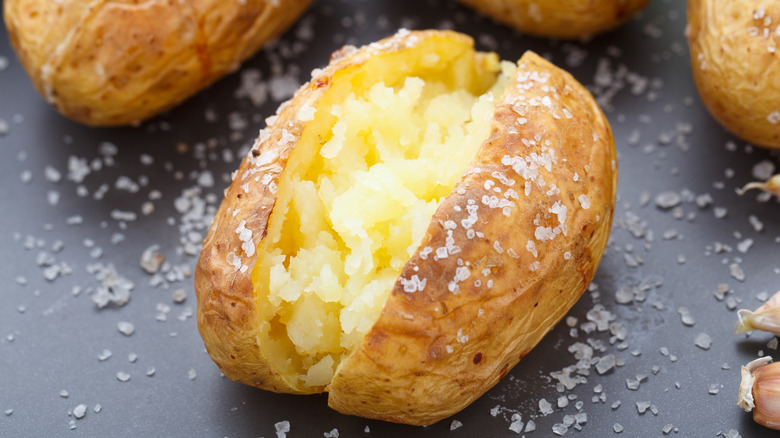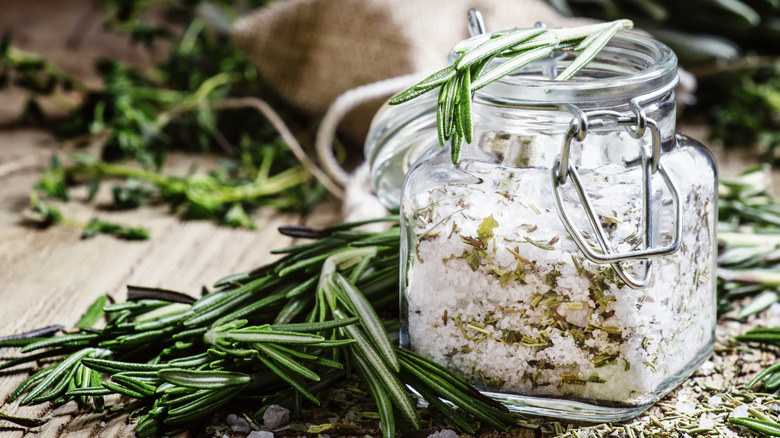Ina Garten's Salt Rub Tip For Golden, Flaky Potato Skin
With a crisp skin and fluffy interior, baked potatoes are an essential accompaniment for barbecues and steaks, as well as making a comforting mid-week dinner; it's easy to add unique toppings to make a meal out of baked potatoes. But whether they're served on the side or center stage, one thing that always elevates a baked potato from good to great is that crispy, salty skin that holds the whole thing together.
There are several tips for getting the best crust, from the best ways to cook a baked potato and the methods you should avoid, with the oven and air fryer usually offering the best results, to the way the potatoes should be prepared before baking. Advice often revolves around pricking the skins, rubbing the potatoes in oil, or whether or not to use foil. But Ina Garten has a top tip that might just become your go-to foolproof method for potatoes with the crispiest, tastiest skin yet, and it's all about an aromatic salt rub.
While many people like to add salt to enhance the flavor of the potato skin, as well as draw out moisture for extra crispiness, the Barefoot Contessa takes things one step further. Rather than just using plain salt, she makes a fragrant, citrusy herb salt to coat the potatoes prior to them going in the hot oven. It means the skin is not just perfectly crisp and flaky but next-level delicious, too.
Ina Garten's herby salt gives potatoes a flavorful crust
The key to getting a good crust on baked potatoes is to choose the right tubers. Large starchy Idaho or russet potatoes offer the perfect combination of fluffy flesh and crispy skins. To prep the spuds for their herby salt rub, scrub and dry them before piercing the skins with the tines of a fork.
To make the salt rub, Ina Garten uses a tablespoon of coarse fleur de sel or sea salt as the base, which gives the potato coating a 'briny flavor' rather than tasting overly salty (via YouTube). She adds it to the bowl of a mini food processor along with fresh herbs, and the zest of a lemon. Garten chooses chopped rosemary and thyme, which pair perfectly with the bright citrusy flavor. The herbs, salt, and zest should be pulsed until they're finely chopped but not so much that they turn to mush; around 10 to 12 pulses should do it.
Rubbing the potatoes all over with olive oil helps the herb salt stick as well as keeps the skins tender and tasty. Then roll them in the herb salt before baking for 60 to 75 minutes until tender. Garten serves her potatoes stuffed with creamy, tangy whipped feta and cream cheese, which makes a great side for steak or chicken, but you could add any loaded toppings of your choice, or just keep them simple to really let the skin shine.
More ways to make and use herb salt rubs
Ina Garten's herb and citrus salt recipe called for a mini food processor, but if you don't have one, there are other ways to make a salt rub. You could use a mortar and pestle, a blender, or a sharp knife and cutting board to finely chop and combine the fresh herbs and zest mix. Or make a larger batch in a regular food processor, and use it for a flavorful addition to many dishes as well as baked potatoes.
The ingredients for herb salt don't need to be limited to rosemary and thyme, and you can use dried herbs and spices as well as fresh. Try experimenting with a salt blend that suits your taste, such as aromatic cilantro with mint leaves, cumin seeds, chiles, garlic, and minced ginger, or try dried oregano, rosemary, and lavender for a fragrant, floral Mediterranean feel. Using dried herbs or spices has the added advantage that the finished salt rub can last up to six months in a sealed jar.
An herbed salt rub can transform most potato dishes; try it sprinkled over roast potatoes or wedges before they're cooked, or when they're hot from the oven as a seasoning. Depending on the herb blend, the salt could also work well on other vegetables, too, as well as making a great crust for meat or fish, or even an inspired addition to popcorn.



